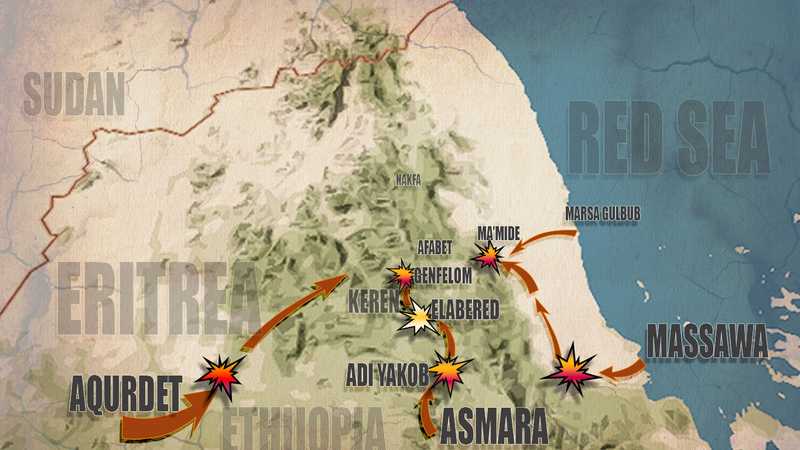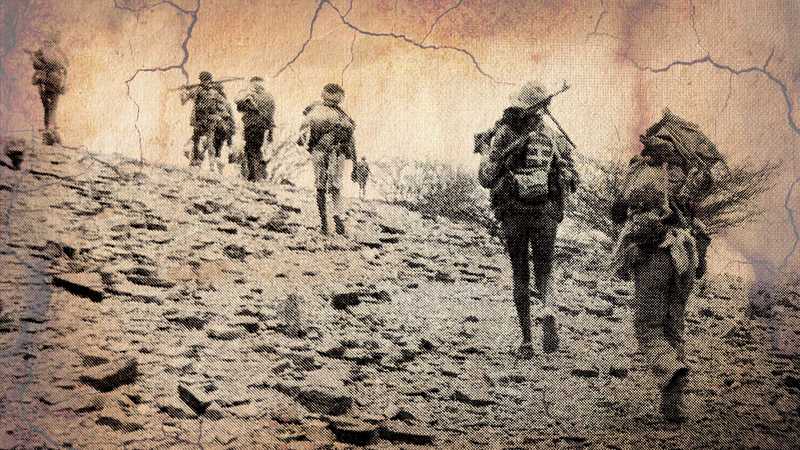Ethiopian Derg Government 2nd Military Campaign Against EPLF
18 Nov, 1978
With a 3-month preparation, the Ethiopian Derg army launched its 2nd military campaign to annihilate EPLF in central highlands of Eritrea.
 Battle map of the 2nd Ethiopian military offensive campaign against EPLF that forced EPLF to retreat toward Sahel
Battle map of the 2nd Ethiopian military offensive campaign against EPLF that forced EPLF to retreat toward Sahel
The Ethiopian army launched its second major offensive against the Eritrean People’s Liberation Front (EPLF) on November 18, 1978. This came three months after the conclusion of the first offensive, which had failed to fully dislodge the EPLF from the central and northern Eritrean highlands. Before initiating this new campaign, the Ethiopian forces spent three months preparing.
The Three-Pronged Attack
The offensive was comprised of attacks from three directions. The first prong moved east out of the port city of Massawa, following the road to Asmara. The second prong attacked EPLF positions at Engerne from the west, launching out of Agordat (Aqurdet) and pushing towards Keren. The third and largest prong struck at the EPLF’s Adi Yakob defenses just northwest of Asmara.
EPLF Positions
At the time, EPLF had established defensive positions at Adi Yakob, northwest of Asmara, the capital of Eritrea (a province of Ethiopia at the time). EPLF also had Keren, 100km north of Asmara, as its central hub. This offensive targeted these positions while closing the circle on EPLF from the northeast, via the coastal flatlands of the northern Red Sea.
Stretching EPLF Defenses in the East
The attack from the port city of Massawa followed the Massawa-Asmara road before splitting northward towards Emberemi at the edge of the Great Rift Valley’s eastern escarpment. It aimed to stretch EPLF forces thin and break through to the city of Afabet. This attack exploited the unprotected coastal plains to swiftly advance forces through Fgret, Mai Awald and She’ib. An additional landing of troops occurred further up the coast at Marsa Gulbub.
Westward Push Towards Keren
From Agordat, the western prong of the attack hit EPLF positions at Engerne and pushed into the open plains leading to the EPLF hub at Keren. Recognizing the mechanized superiority of the Ethiopian force on open ground, the EPLF made the decision not to mount a sustained defense at Begu. Instead, they withdrew to establish defensive positions around Keren. However, Keren soon proved untenable. The EPLF pulled back farther north to Genfolom to regroup and attempt to halt the Ethiopian advance.
 Tegadelti marching up a hill in battle
Tegadelti marching up a hill in battle
The Battle of Adi Yakob: An Overwhelming Central Attack
The heaviest fighting began on November 21st with the Ethiopian attack out of Asmara on the EPLF defenses at Adi Yakob. After an intense artillery barrage, in a blitzkrieg move, Ethiopian tanks breached the trenches, burying alive EPLF fighters who stood their ground heroically. Adi Yakob fell.
The Battle of Elabered
With the overall development on all fronts, and following the loss of Adi Yakob, the EPLF made the strategic decision to carry out an orderly withdrawal while mounting calculated defensive stands at key points. An opportunity soon presented itself. An Ethiopian armored column recklessly rushed through the Elabered narrow pass on the Asmara-Keren road. This force, fresh and confident from the victory at Adi Yakob, was rushing to take Keren.
On November 25, 1978, at the Battle of Elabered, as it has come to be known, EPLF fighters scrambled and launched a counter-attack catching the Ethiopians by surprise at the pass. This surprise attack pinned the overextended Ethiopian military convoy against the hillsides on its right while leaving it exposed to artillery from its left. This soon descended into hand-to-hand combat, with EPLF fighters disabling 13 tanks. A huge stockpile of ammunition was also captured.
Decisive Stand at Ma’mide
On the eastern coastal plain, Ethiopian forces were racing west to cease Afabet, aiming to complete the encirclement and shut EPLF’s escape route north. An additional force had landed at Marsa Gulbub to join the attack. However, their infantry was weakened by the harsh desert trek. The EPLF took advantage, mounting a staunch defense at Ma’mide which halted the Ethiopian drive. Regrouping, EPLF forces then transitioned to a counteroffensive which conclusively stopped the coastal advance.
Withdrawal to Sahel
Having blunted the three-pronged offensive, the EPLF made the strategic decision to pull back from most occupied areas including Keren. The rugged, mountainous Sahel province in the north was chosen as its base for mounting defenses for all future Ethiopian army’s offensives, and from where it would launch all its future counter-offensives.
